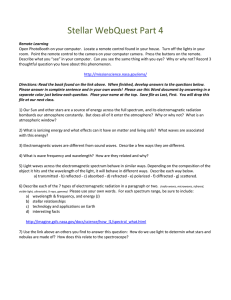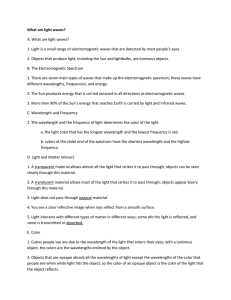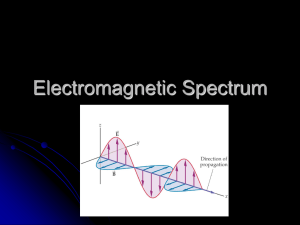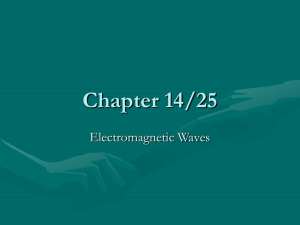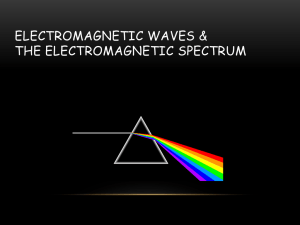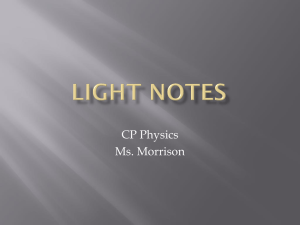Electromagnetic Waves and Color
advertisement
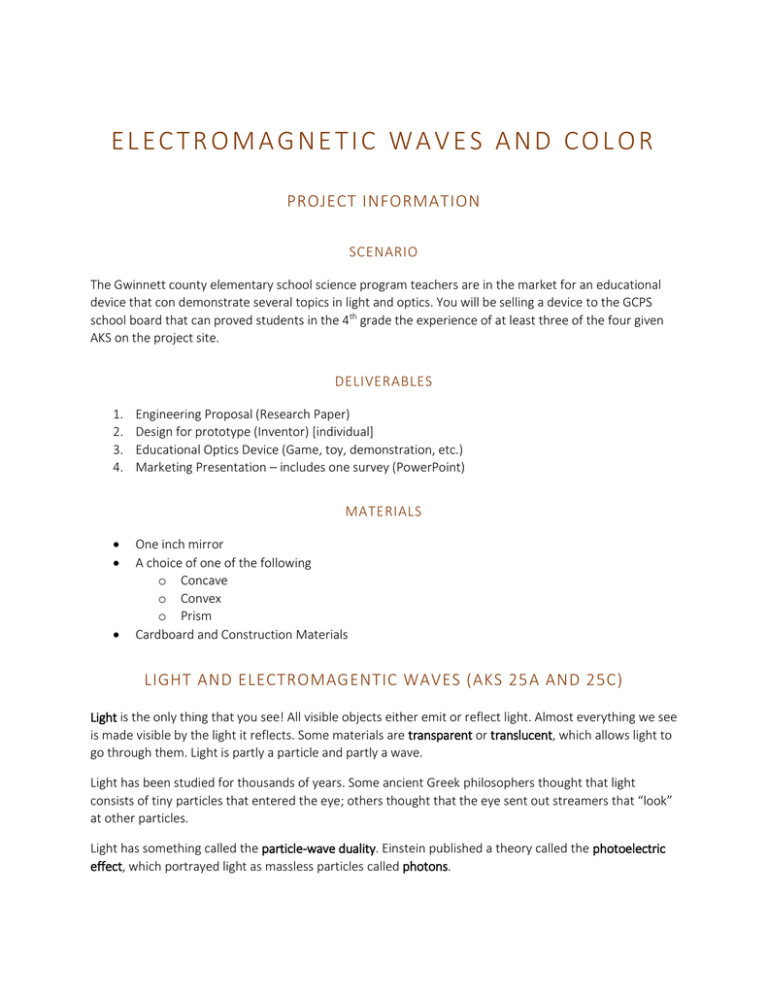
ELECTROMAGNETIC WAVES AND COLOR PROJECT INFORMATION SCENARIO The Gwinnett county elementary school science program teachers are in the market for an educational device that con demonstrate several topics in light and optics. You will be selling a device to the GCPS school board that can proved students in the 4th grade the experience of at least three of the four given AKS on the project site. DELIVERABLES 1. 2. 3. 4. Engineering Proposal (Research Paper) Design for prototype (Inventor) [individual] Educational Optics Device (Game, toy, demonstration, etc.) Marketing Presentation – includes one survey (PowerPoint) MATERIALS One inch mirror A choice of one of the following o Concave o Convex o Prism Cardboard and Construction Materials LIGHT AND ELECTROMAGENTIC WAVES (AKS 25A AND 25C) Light is the only thing that you see! All visible objects either emit or reflect light. Almost everything we see is made visible by the light it reflects. Some materials are transparent or translucent, which allows light to go through them. Light is partly a particle and partly a wave. Light has been studied for thousands of years. Some ancient Greek philosophers thought that light consists of tiny particles that entered the eye; others thought that the eye sent out streamers that “look” at other particles. Light has something called the particle-wave duality. Einstein published a theory called the photoelectric effect, which portrayed light as massless particles called photons. Light is a portion of the family of electromagnetic waves that include radio waves, microwaves, and X-rays. The range of electromagnetic waves is called the electromagnetic spectrum. Energy increases as you go up in the spectrum. The order for visible light is red, orange, yellow, green, blue, and violet. Each color has its own frequency and is continuous, like a color wheel. As you go forward in the sequence frequency, and therefore energy, increases. On the other hand, wavelength decreases. 𝜆 (𝑙𝑎𝑚𝑏𝑑𝑎) is the symbol for wavelength, and is measured in meters, or other distance measurements. 𝜆 ∗ 𝑓 = 𝑣𝑒𝑙𝑜𝑐𝑖𝑡𝑦 The speed of all electromagnetic waves are always 3 ∗ 108 . This is denoted the variable 𝐶, which is the speed of light. Our eyes have been evolved to see the yellow-green wavelengths most prominently because that is what the sun produces at the highest intensity (bell curve). The lowest frequency of light is red. The highest visible light, violet, has about double the wavelength of red light. Electromagnetic waves of frequencies lower than the red of visible light are called infrared. Heat lamps give off infrared waves. Electromagnetic waves of frequencies higher than that of visible light are called ultraviolet. They are responsible for sunburns. COLOR (AKS 25I, 25J, 25K) Sunlight is composed of all the colors of the rainbow – discovery accredited to Newton. Sunlight is an example of white light. White is not a color, but rather the combination of all lights being added together. Black is also not a color; it is the absence of light. Even polished surfaces, when not reflecting back to your eye, will appear black because no light reaches your eye. The color of an opaque object is the color of the light that it reflects. Different light sources are going to make colors appear different. Candle flame – emits lower frequencies only (yellowish) Incandescent light – all frequencies, but richer towards the lower end (reds mainly) Fluorescent light – all frequencies but mainly the higher ones (blue-ish) A rose will not reflect green light, and therefore will be black under green light. Tinted glass means that all other frequencies are reflected, but one type of frequency is allowed through. What you see is always the wavelength that goes towards your eye. Red, Green, and Blue are the three primary colors of light, because they produce the greatest combination of colors. Red and green makes yellow; blue and red makes magenta; blue and green produce cyan. All three combined at the same intensity will produce white. The colors of light being combined is called additive color combining. Cyan, Magenta, and Yellow are the three primary colors of pigments, because they are secondary colors of light. Yellow and Cyan produce green, yellow and magenta produce red, and cyan and magenta produce blue. All three at the same intensity produce blue. This is called subtractive color combining. Complementary colors are opposite colors on the color wheel. For example, yellow and blue are primary colors because they are opposite each other on the color wheel. Every color has a complementary color. If you subtract a color from white light, their complementary color is shown. For example, if you have a yellow object, it will absorb all blue light, and if you have a red object, it will absorb any cyan light. LASERS Laser is an acronym for light amplification by stimulated emission of radiation. They have three properties. 1. Monochromatic – they emit a single wavelength only 2. Directional – not diffuse; all in same direction 3. Coherent – all photons are identical PRACTICE 1. What light color do you add to blue light to obtain white light? Yellow. This is because yellow and blue are complementary colors. 2. What primary pigment colors must be mixed in order to get red? Look at the subtractive color wheel. Magenta and yellow combine to produce red. 3. What color will a yellow banana appear when illuminated by a. White light? Yellow. It will only reflect the yellow light. b. Green and red light? Yellow. Green and red light produce yellow light. Therefore, it will reflect the yellow light back. c. Blue light? Black. It will absorb all the blue light, and therefore there will be an absence of light. VOCABULARY Term Light Transparent Translucent Particle-wave duality Photoelectric effect Photons Electromagnetic waves Electromagnetic spectrum Infrared Ultraviolet Opaque Tinted Primary colors Complementary colors Laser Monochromatic Directional Coherent Definition Waves in the visible range on the electromagnetic spectrum Allowing light to pass through Partly transparent – allows light, but not detailed images to be seen The property of light being both a wave and a particle The observation that many metals emit electrons when light shines on them. Massless particles of light (or anything else on the electromagnetic spectrum) Waves on the electromagnetic spectrum that include light and radio waves as well as many others The spectrum upon which electromagnetic waves are organized The area of the electromagnetic spectrum with a lower frequency than visible light The area of the electromagnetic spectrum with a higher frequency than visible light (of an object) doesn’t allow light to travel through (of an transparent object) colored to only allow a specific frequency through Colors that create the majority of all colors on the spectrum Colors that are directly opposite from each other on the color wheel Light amplification by stimulated emission of radiation The property of having only one color All waves moving parallel in the same direction All photons in a laser are identical

